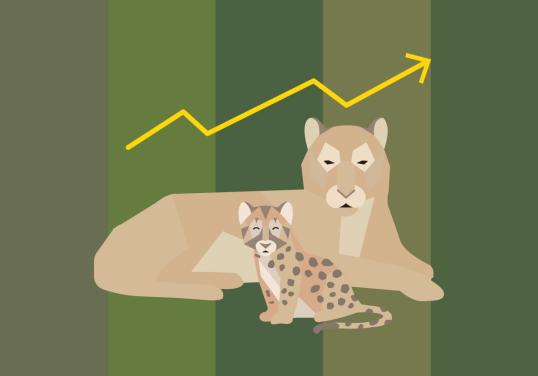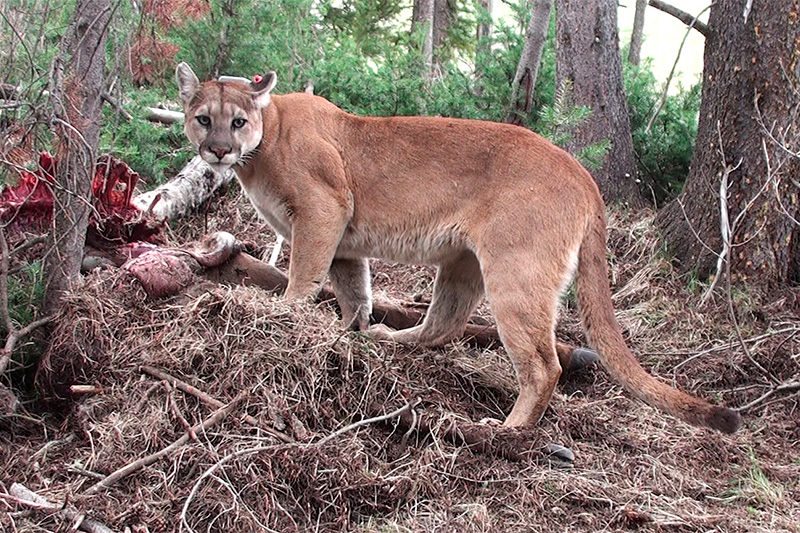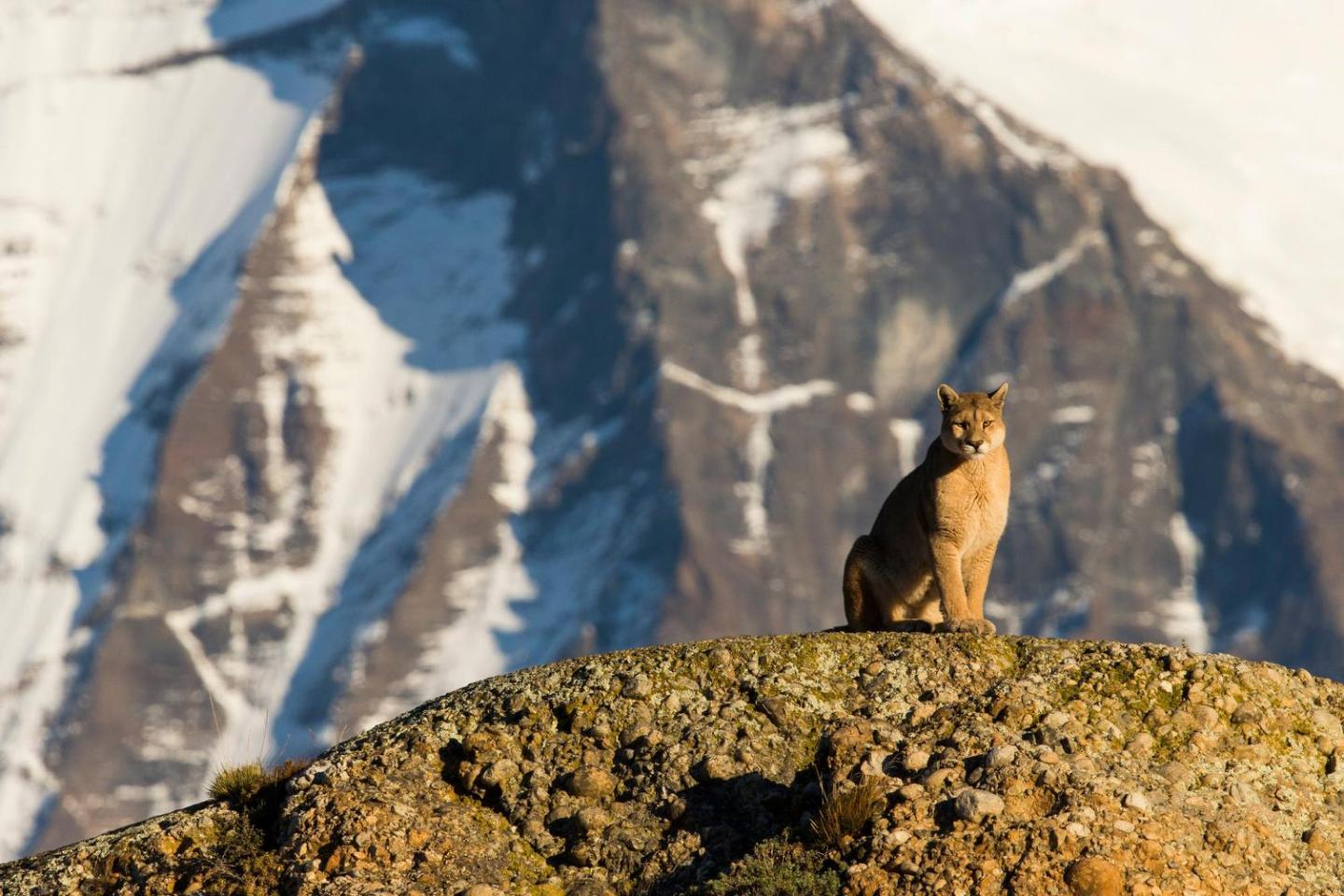About Pumas
The puma (Puma concolor) — also known as the cougar, mountain lion, panther, and catamount — lives in 23 countries in the Americas. Despite its wide range, the puma remains poorly understood in many areas and its numbers are thought to be declining overall. Together, we are creating a new image of pumas, one that is integral to the landscapes and ecosystems supporting human communities in the Americas. Whether through research, monitoring, education, or outreach, Panthera positions coexistence between pumas and people at the center of conservation.
Our Puma Program's goal is that, by 2030, puma populations are increasing or stable in five key transcontinental strongholds containing different subspecies, and that the puma’s range has expanded by 1,167,856 square km (or 450,912 square miles). This will be achieved by facilitating the deployment of proven conflict-mitigation measures at large scales, securing functional connectivity between population strongholds, and supporting the development and implementation of conservation policies that reduce direct threats to puma survival.
Visit Puma ProgramOur Goals

Puma populations are increasing or stable in five key transcontinental strongholds with different subspecies by 2030.

The puma’s range has expanded by 1,167,856 square km (or 450,912 square miles) by 2030.
Where Do Pumas Live?
The puma has the largest geographic range of any native terrestrial mammal in the Western Hemisphere, spanning 23 countries from southern Alaska down to the southern tip of Chile. Pumas inhabit every forest type across their range as well as montane deserts and open steppe grasslands.
Where We Work
United States: Our flagship Olympic Cougar Project, co-led by Panthera and the Lower Elwha Klallam Tribe in collaboration with the Skokomish, Makah, Jamestown S'Klallam, the Port Gamble S'Klallam Tribes, the Quinault Indian Nation and the Washington State Department of Transportation, is located in western Washington in the Pacific Northwest. Our collaborative Bay Area Carnivore-Livestock Interactions Project is located just south of San Francisco along the central coast of California. We work in the Northeast in the collaborative Cougar Research Collaborative, a working group exploring the feasibility of puma reintroductions in the East. We also work in Texas on policy and puma genetics, and hope to expand our policy work into new areas.
Chile: We work in southern Patagonia with partners Leona Amarga and Fundación Cerro Guido Conservación to test various tools that potentially decrease negative puma-livestock interactions, and to build sustainable, safe puma tourism guidelines. We also partner with Estancias Lazo, las 3R, Las Cumbres y Baguales, La Sofia, and La Herradura on monitoring pumas and establishing wildlife-friendly ranching practices.
Brazil, Colombia, Guatemala, Honduras, and Costa Rica: We work side-by-side with our partners and jaguar researchers to install carnivore deterrents like guardian buffalo, Foxlights, scarecrows, and fences meant to increase livestock safety and reduce rancher retaliation that kills so many big cats in Latin America. We are also exploring puma connectivity and genetic health across many countries in the region.
- Historic Range
- Current Range
FAQs
What do pumas eat and how do they hunt?
While pumas eat a wide range of prey, they primarily eat large and medium-sized hoofed mammals, like deer and collared peccaries. Young pumas generally eat smaller prey, including American beavers, porcupines, and raccoons, as they hone their skills and grow.
What is the Florida Panther?
Pumas were eliminated from the entire eastern half of North America, except for a tiny population in Florida that was rediscovered in 1972. Today, the remnant puma population in Florida (known as the Florida panther) is endangered but recovering.
Can pumas be all black?
No. Unlike jaguars and leopards, pumas are not known to exhibit melanism (commonly referred to as “black panthers”).
What are the threats facing pumas?
In the United States, pumas are primarily threatened by habitat loss and fragmentation, but they face numerous other challenges, including legal hunting, vehicle strikes and disease. In Latin America, they face the same threats, as well as significant illegal poaching and retaliatory killing by ranchers due to real and perceived attacks on livestock. Across Latin America, wide-scale decreases in wild prey availability, sometimes driven by poaching, further causes hardship for this species.
How can we save pumas?
Panthera’s Puma Program has four main goals: 1) fill knowledge gaps about pumas, including their range-wide distribution and abundance, and their ecological contributions in ecosystems, 2) address habitat fragmentation impacting the interconnectedness of puma populations, 3) reduce legal and illegal puma hunting and trapping where it threatens the integrity of puma populations, 4) reduce human-puma conflict and increase human tolerance for pumas.








